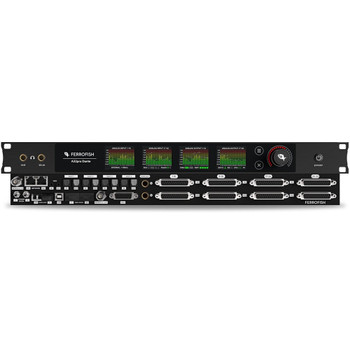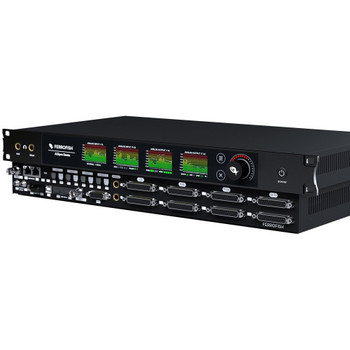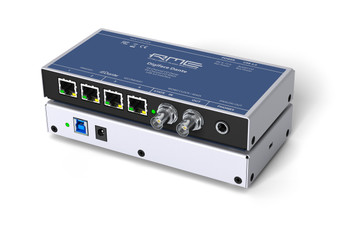Description
M-1620 Pro D
16 channel A/D, 20 channel D/A converter with ADAT, Dante®, MADI
The RME M-1620 Pro D converts 16 analog line-level signals (per channel switchable up to +24 dBu) to and from MADI, ADAT and Dante network technology. This innovative unit is designed with a newly developed front panel that combines LED level meters with a display and includes two separate headphone outputs for monitoring - all within a single-height 19-inch rack device. Cutting-edge converters and flexible internal routing place it at the forefront of any audio network.
Connectivity and Features
- 16 x Line Input
- 16 x Line Output
- 2 x Phones Output
- 4 x ADAT I/O
- 1 x MADI Optical SFP (optional)
- 1 x Redundant PSU (optional)
- 1 x Word Clock I/O
- 1 x MADI I/O coaxial
- 2 x Gigabit Ethernet (802.3 compliant)
- SteadyClock FS
- DC-coupled Outputs
- USB for firmware & remote control
Simplicity at first glance - Flexibility and reliability beyond
RME prioritizes reliability by equipping the M-1620 Pro with built-in redundancy. This includes dual network and dual MADI connections, along with a monitored DC input in addition to the internal AC power supply. A unique system clearly signals when an issue arises, ensuring seamless operation. With full stand-alone capability, users can adjust device settings directly on the unit for quick modifications or to recall entire user-defined presets.
Responding to frequent requests, the M-1620 Pro D integrates 64 channel Dante connectivity, providing direct links to other audio devices via standard ethernet switches. If redundancy is not required, the device can act as a switch itself and allow daisy-chains of several Dante devices. Users can record and playback up to 64 channels of any of the M-1620’s analog and digital I/O on their computer using Audinate’s Dante Virtual Soundcard™ (license not included).
Add Analog and DANTE I/O to any existing MADI devices
The M-1620 Pro allows manual configuration of the converter’s aliasing filters for optimal impulse and frequency response. Jitter on digital input signals is effectively reduced with SteadyClock FS. Separate Word Clock BNC and coaxial MADI connectors, with optional optical MADI via an SFP module, allow the device to be easily integrated into existing infrastructure.
Plug & play - rapid user interaction
Control all device states directly from the front panel for convenient, direct access to all features. RME network audio devices can be reached over network (including wirelessly over Wi-Fi) and USB for convenient remote access, allowing the rapid creation of gain groups, phantom power switching and clock configuration. In addition, a JSON based API and even SysEx MIDI commands can be used to integrate each model virtually anywhere. The integrated routing matrix allows single channel routing across all analog and digital I/O. As such, problem-solving of signals, clocking, connectivity or other issues is both simple and straight-forward!
Specifications
- Line In 1-16:
- Resolution: 24 bit
- Input level switchable per channel +24 dBu, +19 dBu, +13 dBu @ 0 dBFS
- Inputs AC coupled, fully symmetrical signal path (servo-balanced)
- Input Impedance 9.5 kΩ
- Signal to Noise ratio (SNR) @ +24 dBu, 44.1 kHz: 117.0 dB RMS unweighted, 120.7 dBA
- Signal to Noise ratio (SNR) @ +19 dBu: 116.3 dB RMS unweighted, 119.9 dBA
- Signal to Noise ratio (SNR) @ +13 dBu: 114.7 dB RMS unweighted, 118.3 dBA
- Frequency response @ 44.1 kHz, -0.1 dB: 5 Hz – 20.5 kHz
- THD @ -1 dBFS: < -111 dB, < 0.00029%
- THD+N @ -1 dBFS: < -108 dB, < 0.00039 %
- Channel separation: > 110 dB
- Line Out 1-16:
- Resolution: 24 bit
- Output level switchable per channel +24 dBu, +19 dBu, +13 dBu @ 0 dBFS
- Outputs DC coupled, fully symmetrical signal path ("truly balanced")
- Output impedance: 200 Ohm balanced, 100 Ohm unbalanced
- Signal to Noise Ratio (SNR) @ 13 dBu: 119.2 dB RMS unweighted
- Signal to Noise Ratio (SNR) @ 19 dBu: 119.7 dB RMS unweighted
- Signal to Noise Ratio (SNR) @ 24 dBu: 119.9 dB RMS unweighted
- Frequency response @ 44.1 kHz, -0.1 dB: 0 Hz – 20.3 kHz (Sharp Filter, default)
- Frequency response @ 96 kHz, -0.1 dB: 0 Hz – 30 kHz (Slow Filter, default)
- Frequency response @ 96 kHz, -0.1 dB: 0 Hz – 44.1 kHz (Sharp Filter)
- Frequency response @ 192 kHz, -0.1 dB: 0 Hz – 60.5 kHz (Slow Filter, default)
- Frequency response @ 192 kHz, -0.1 dB: 0 Hz – 85 kHz (Sharp Filter)
- THD @ 19 dBu: < -120 dB, < 0.0001 %
- THD+N @ 19 dBu: < -113 dB, < 0.0002 %
- Channel separation: > 110 dB
- Phones 1/2, 3/4:
- Resolution: 24 Bit
- Output: 6.3 mm TRS stereo (unbalanced) or mono (balanced) jack
- Maximum output level +4 dBu / +19 dBu (+10 dBu / +25 dBu in balanced mode)
- Output level switchable separately for each TRS connector
- Signal to Noise Ratio (SNR) @ 19 dBu: > 109 dB RMS unweighted, > 111 dB(A)
- Frequency response @ 44.1 kHz, -0.1 dB: 0 Hz – 20.0 kHz (Sharp Filter, default)
- Frequency response @ 96 kHz, -0.1 dB: 0 Hz – 20.0 kHz (Slow Filter, default)
- Frequency response @ 96 kHz, -0.1 dB: 0 Hz – 44.3 kHz (Sharp Filter)
- Frequency response @ 192 kHz, -0.1 dB: 0 Hz – 43 kHz (Slow Filter, default)
- Frequency response @ 192 kHz, -0.1 dB: 0 Hz – 85 kHz (Sharp Filter)
- THD+N @ 4 dBu, 32 Ohms load: < -100 dB, < 0.001 %
- THD+N @ 19 dBu, 100 Ohms load: < -100 dB, < 0.001 %











